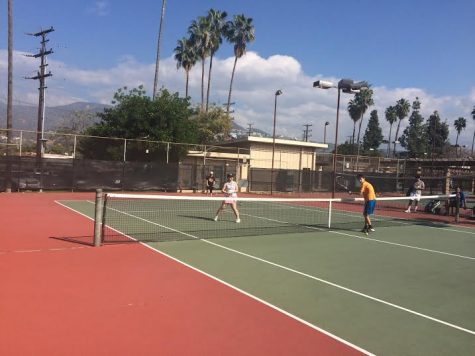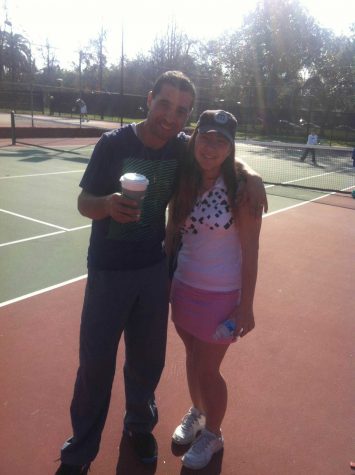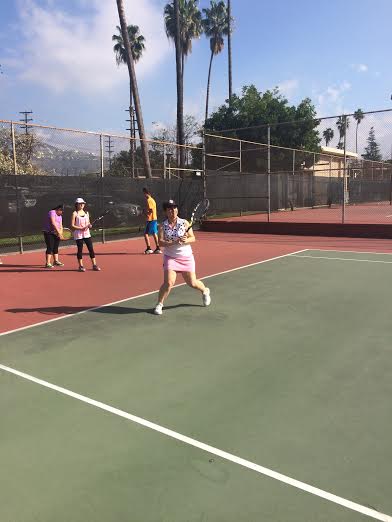Sports injuries affect youth sports players
January 31, 2015
“I felt very frustrated after my injury and there were a lot of times I could not make practices and wanted to give up on tennis,” said Cynthia Shamerzian, a junior at Clark. Shamerzian was experiencing a somewhat intense pain after getting an arm injury during tennis practice last year.
Many teens like Shamerzian have experienced injuries during their sports practices. According to the Young Sports Safety Statistics, high school athletes suffer 2 million injuries, 500,000 doctor visits and 30,000 hospitalizations each year.
Shamerzian was playing for the Hoover High School girls tennis team in November of 2014, when she felt a swelling on her arm after practice. She had been playing tennis with an opponent and when stretching her arm to hit the ball with the racket, she felt pain. According to the American Academy of Orthopedic Surgeons (AAOS), when a sports injury occurs, it is important to quickly seek proper treatment. To ensure the best possible recovery, athletes, coaches and parents must follow safe guidelines before the athlete returns to the game.
Shamerzian went to the doctor for a check-up immediately after a night of swelling and pain in her left arm. At her visit to the doctor, Shamerzian discovered she had pulled her tendon, and this shocking setback was overwhelming to her because she had just been placed on the Varsity team for tennis. According to the AAOS, once torn, the biceps tendon at the elbow will not grow back to the bone and heal. Other arm muscles make it possible to bend the elbow fairly well without the biceps.
Shamerzian was unsure and in doubt that she could continue playing tennis, but she still wanted to play. “I was the youngest one in varsity so I felt more pressure on myself to do better, even with my injury,” she said. Her injury required a clothed cast and a wrap tied from her neck to her arm. She was also thankful that her injury was not as serious as it could have been, because if she had pulled her muscle a bit more she would have ruptured her arm and be in need of surgery. According to the AAOS, high school sports injuries can cause problems that require surgery as an adult, and may lead to arthritis later in life.

Junior Cynthia Shamerzian playing tennis with the rest of the members of her private tennis group, they are going through warm ups.
Shamerzian was devastated by the fact she experienced this injury during her major game season. Playing matches with an injury was a setback, as she could not play her best during one-on-one tennis matches. Though the pain from the original injury has since lessened, Shamerzian said she still experiences arm pain at times when she plays with her private tennis group.
According to the Nationwide Childrens website, with an estimated 25 million scholastic and another 20 million organized community-based youth programs in the United States, the opportunity for injury is enormous.
Other students have experienced the aftermath of sports after an injury as well. Junior Adelina Sefiani, a lifeguard and swim team member, had to go to the emergency overnight after a painful shoulder injury. Sefiani was swimming a 500 (20 laps) when her coach instructed the team to do a butterfly routine (the butterfly is a swimming stroke swum on the breast, with both arms moving simultaneously, accompanied by the butterfly kick).
During the butterfly, Sefiani felt what she said was an “aching pain in her shoulder.”
“My arm was going out of the water and my shoulder made a up and down movement,” Selfiani said. She went to the emergency room that night when the pain was intolerable and learned her shoulder bone had popped out. According to the Nationwide Childrens website, sports injuries are the second leading cause of emergency room visits for children and adolescents, and the second leading cause of injuries in school.
Serlina Nazarian, a junior at Clark, experienced a more minor yet painful injury during PE at Clark. Nazarian was in her physical education class last year and was playing basketball. “I was playing and my friend threw the ball at me… and my left finger bended very painfully,” Nazarian said. Nazarian saw a bruise develop immediately and a darkening around the bottom of her finger. “I was sure my finger was broken… I was so scared.” According to the AAOS, if not treated properly, serious finger injuries can lead to permanent deformity and loss of function.

Junior Cynthia Shamerizian and her coach.
Nazarian saw swelling continue and went to the Glendale Adventist hospital for an X-ray the same day. Nazarian said that the doctors there discovered she had lost blood circulation in that finger and prescribed for her a cast to wear. “I’m a lefty and it was really hard for me to write with my right hand,” she said.
Nazarian was excused from physical education for a week and a half. According to the Nationwide Childrens, approximately three million youth are seen in hospital emergency rooms for sports-related injuries and another five million youth are seen by their primary care physician or a sports medicine clinic for injuries.
According to Judy Thomsen, a tenth grade physical education teacher, the greatest number of injuries at Clark are sprained ankles. According to Thomsen, the time students get off from physical education “depends on severity of the injury… it can range from six weeks to a rest over night.” Basketball and soccer injuries seem most prevalent, she said, “because those sports are highly active and require demand.”
